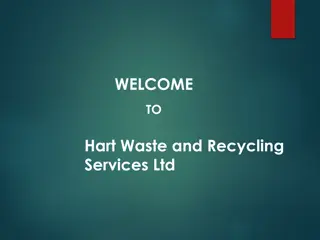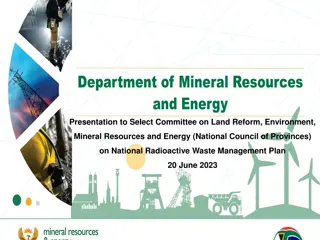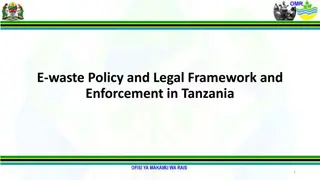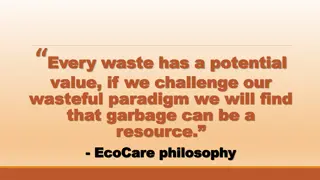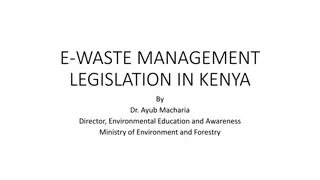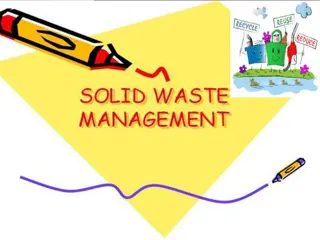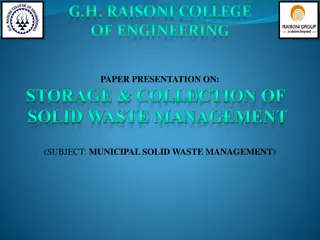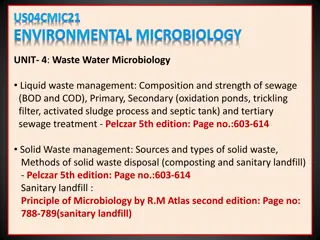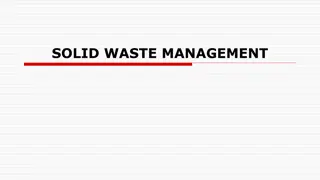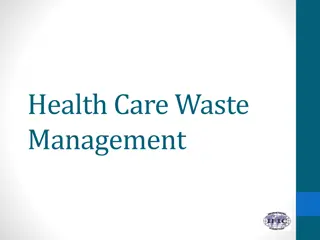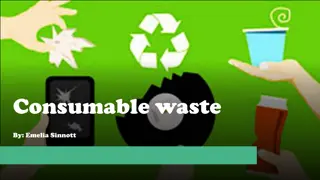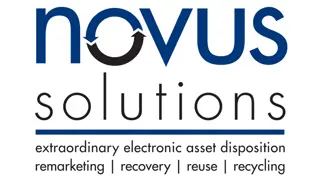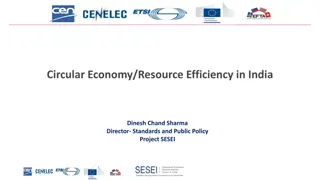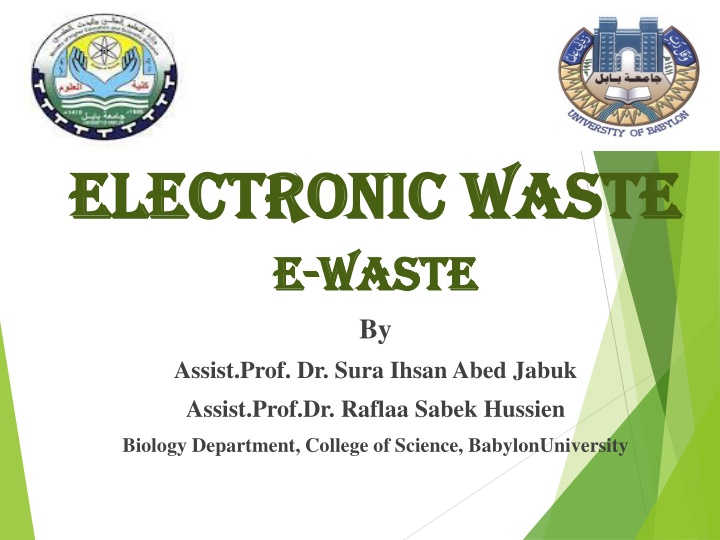
Electronic Waste and Its Impact
Metal and plastic components dominate e-waste, posing environmental and health hazards due to toxic substances. E-waste includes a variety of discarded electronic devices containing valuable materials. Proper handling and recycling are essential for mitigating its adverse effects and promoting a circular economy.
Download Presentation

Please find below an Image/Link to download the presentation.
The content on the website is provided AS IS for your information and personal use only. It may not be sold, licensed, or shared on other websites without obtaining consent from the author. If you encounter any issues during the download, it is possible that the publisher has removed the file from their server.
You are allowed to download the files provided on this website for personal or commercial use, subject to the condition that they are used lawfully. All files are the property of their respective owners.
The content on the website is provided AS IS for your information and personal use only. It may not be sold, licensed, or shared on other websites without obtaining consent from the author.
E N D
Presentation Transcript
Electronic Electronic waste E E- -waste waste By Assist.Prof. Dr. Sura Ihsan Abed Jabuk Assist.Prof.Dr. Raflaa Sabek Hussien waste Biology Department, College of Science, BabylonUniversity
Introduction Metal and plastic make up the majority of the components in e-waste, but it also contains trace amounts of dangerous substances and heavy metals (such those found in printed circuit boards). It is challenging to make broad statements regarding the material content of e-waste due to the wide variety of distinct forms. Refrigerants are substances that are used to chill objects, such as in refrigerators and air conditioners. The ozone layer and climate change may both be affected by these refrigerants.
Electronic waste Electronic waste, or "e-waste," is the term used to describe a range of electric and electronic devices that are no longer functional or valuable to their users. Electronic debris (e-waste) includes both "white goods" like refrigerators, washing machines, and microwaves as well as "brown goods" like televisions, radios, computers, and mobile phones that have outlived their usefulness via rendundancy, replacement, or breakdown. Since the information and technology revolution has quickly increased the use of new electronic equipment while simultaneously creating large amounts of ineffective devices, e-waste is one of the fastest-growing waste sources.
Con. E-waste is different from regular municipal trash in that it frequently includes valuable materials that may be recovered in addition to intricate mixtures of very poisonous substances that are harmful to both human health and the environment. It now has one of the fastest growing waste sources. It includes a wide range of technology, including solar panels, mobile phones, computers, TVs, refrigerators, household appliances, and lighting. It also includes medical equipment.
Con. E-waste is made up of a complicated collection of substances, some of which are dangerous. If the abandoned gadgets are not treated appropriately, these might have serious negative effects on the environment and human health. Critical raw materials, as well as rare and expensive resources, are also present in modern electronics. If the garbage is properly handled, they can be recycled and reused. several gadgets, including smartphones, laptops, TVs, refrigerators, home appliances, lighting, and medical equipment
Con. The transition to a circular economy may be supported by improving the collection, handling, and recycling of electrical and electronic equipment at the end of its useful life. Additionally, it can help ensure the supply of vital raw resources, thus boosting the EU's strategic autonomy.
Importance of E-waste Technology has merged into our daily lives in the modern world. Almost all of our activities include the use of electronic gadgets, including work, pleasure, communication, and education. But as technology has developed so quickly, a new issue called e-waste has arisen. E-waste will be defined in this article, along with the reasons why it must be addressed.
Types of E-waste: Understanding the Different Kinds of Electronic Waste Electrical devices have become a necessary component of our life as technology has advanced. The issue of electronic debris, or "e- waste," is brought on by the growing usage of electronic gadgets. Electronic equipment or gadgets that have reached their end-of-life, are no longer in use, or are outdated are referred to as "e-waste." These gadgets frequently end up in landfills, presenting serious dangers to the environment and human health. We can handle and recycle these devices more effectively if we are aware of the many sorts of electronic trash. The following are some of the most typical e-waste types:
Con. freezers, refrigerators, and other cooling devices. Computers and communication devices. Consumerelectronicdevicesandsolarpanels. TVs, monitorsandscreens. LEDbulbs. Vendingmachines.
Recycling of E- waste https://e-stewards.org/learn-more/for-consumers/overview/where-does- your-e-waste-go/
Recycling of E- waste Metals and other materials recovered from waste electric and electronic equipment provide a significant possibility due to their high value and re-use in high-tech components and products. The demand for such resources has risen dramatically in recent years, posing serious supply difficulties, particularly when their availability is both constrained and conditioned by the monopoly held by primary producers.
Con. E-waste recycling is far more difficult than traditional debris recycling. Manual sorting is typically the initial stage in the recycling process. Workers separate e-waste into groups based on its kind and model after it has been collected and transferred to recycling facilities. Then, all electronic gadgets will be evaluated, and the pieces that are still working will be taken and repurposed; they can be sold individually or combined to build a new phone or computer. The non-functional e-waste that is left behind will be recycled.
Con. In this facility, e-waste is thrown into a massive machine and shredded into tiny bits of information but first it must go through a process known as de-manufacturing, which refers to the action of deconstructing a product into components. This method is used to remove any potentially dangerous elements from electronic equipment that may otherwise ruin the machine or pollute the environment if disposed of in landfills.
Con. Given that so many objects may serve as fuel sources, such as plastic, toner found in photocopiers, for instance, is incredibly combustible and explosive and is definitely capable of blowing up the processing equipment if it is shredded. This procedure must be carried out by skilled employees because of its importance. Metals, the important components that make e-waste recycling a lucrative industry, will be extracted from the debris once it has been shred. This technique does not require human sorting like the other sessions. All the ferromagnetic substances, such as iron and steel, that have a high susceptibility to magnetization will initially be drawn to a massive magnet.
Technical Features The method uses hydrometallurgical techniques (in liquid form), carried out at almost room temperature, low-priced and with limited gas emissions in the air, allowing the almost integral recovery of gold and stannic oxide from electronic circuit boards in the first extraction phase using nitric acid. Further phases of the process allow for the recovery of silver, copper and lead sulphate with scalable degree of purity based on market needs.
Conclusions The massive inappropriate disposal have a serious negative impact on both the environment and human health. In addition to the environmental and health risks, there is a chance for resource recovery from e-waste, thus appropriate e-waste recycling attention. E-waste contains a variety of precious metals, and when it is landfilled, recoverable metals are lost, disrupting the entire material cycle. production of e-waste and its should get rapid

